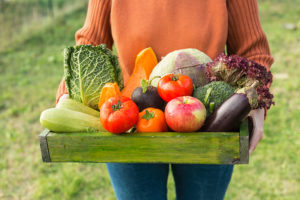
This a welcome time to cherish sandcastles at the beach, woodland hikes, cool drinks on the deck and, of course, fantastically fresh food.
Food is grown year-round in most places, but in the Midwest the agriculture truly shines during spring, summer and fall.
Local restaurants are quick to advertise locally grown fruits and veggies.
Why does this matter? While it may seem trendy to eat local foods by the season, there are more benefits to this practice than simply being on trend.
The two biggest reasons to eat by the season: flavor and price.
Fruits and vegetables are at the height of their flavor when they are picked at peak ripeness. Have you ever bit into a tomato fresh out of the garden? Enough said.
And as price goes, when a particular fruit or veggie is in season, it is typically available in abundance. Out-of-season cucumbers will run you $1 each at the supermarket. At peak season, you can get 5 for $1.
And berries—dare we talk about those? We all know how expensive berries can be, especially out of season.
When you buy in bulk over the summer, you can save a bundle. Better yet, visit a pick-your-own farm. Make an event out of it and bring your kiddos, grandchildren, nieces or nephews. They get to burn off some energy while enjoying a delicious snack—and they’ll never forget the experience.
In fact, I speak from experience. My own grandparents had a fruit farm, which still houses some of my favorite family memories. Now, as a mom of three myself, I make it a priority to invite our trio into the adventures of food. They’re thrilled when the task at hand is their favorite food group: fruit!
Whether you opt for cherries, blueberries, strawberries, apples, pears or peaches, I guarantee you will look forward to a repeat event.
Calendar mindset
We can all use the added incentive and inspiration to help us eat more fruits and veggies.
But how do you get started? Where can you find seasonal produce? And what should you eat?
From May to October, it’s fairly simple to determine what is in season. All it takes is a quick visit to your local farm market. You can also sign up for a farm share or a community supported agriculture group, commonly referred to as a CSA.
That’s an experience I will never forget: my first year as a CSA member. (If that term is new to you, a CSA is a program in which you purchase a farm share for a season and, in turn, the farm shares a portion of their crop yield with you.)
As a newly engaged woman, I had been cooking with hopes of ever impressing my handsome fiancé. It was to my chagrin to find two alien-esque vegetables in our CSA delivery that first season, both looking more like roots than food. After a bit of Googling, I determined they were in fact edible roots: celeriac and kohlrabi.
After a bit more searching and a phone call to my mom, I found hope with a few recipes.
Whether you choose to join a CSA or peruse your local farmers market, you will gain great insight into the produce available each season.
And when flavor and price aren’t enough to inspire you to eat more fruits and veggies, creativity will certainly lure you in.
Here are some great ways to incorporate fresh, seasonal produce into your family meals:
Summer
If you visit a farmers market from June to August, a rainbow of options will greet you: fresh green beans, strawberries, leafy greens, zucchini, heirloom tomatoes, cucumbers, beets, stone fruit and rich dark cherries.
When it comes to leafy greens, I have acquired the reputation for being a bit kale-centric. It’s loaded with nutrition, it fights cancer, it lasts forever as a prepped-ahead salad—curly kale seriously does not wilt for days—and it delivers a surprisingly delicious flavor.
I use kale for all kinds of salads and dishes. My favorite combinations include a homemade vinaigrette, toasted walnuts, diced avocado, strawberries and grilled chicken or chickpeas. Quite honestly, you cannot go wrong with testing your creativity when it comes to a kale salad.
Fall
When summer comes to a close—perish the thought!—farm fresh produce is still in full swing. Pumpkins, winter squash, potatoes, artisanal products such as preserves, honey and baked goods are available in abundance.
With beets at their prime, you’ll certainly need to invite these deep-hued veggies into your kitchen. Use them to add a beautiful shade of maroon to a beet and carrot slaw, or puree them into a pink hummus.
You could simply roast them in the oven, too, or use them to whip up a batch of “unbeetable” delicious chocolate cupcakes. You can find all kinds of amazing recipes online.
Winter
I’ve said it before and I’ll say it again: Take advantage of a warm oven on the cold days of winter and roast your vegetables. Not only will roasting serve as a makeshift fireplace in your kitchen, it also transforms the flavor and texture.
Take, for example, cauliflower or broccoli. They’re bitter and crunchy when raw, but once they’re roasted they become nearly sweet, thanks to caramelization. And the texture will shock you. Cauliflower nearly melts in your mouth. Broccoli can acquire a crisp flower over its soft interior.
Paired with olive oil, herbs and spices, these types of veggies can become nearly as addicting as a pre-dinner nosh.
I tend to toss any winter vegetables I have on hand with a bit of olive oil, rosemary and thyme before roasting them at 450 degrees in my Dutch oven, or on a baking sheet if I want a crisper finish.
If you’re new to roasting veggies, begin your experimentation with cauliflower, Brussels sprouts, carrots, parsnips, sweet potatoes, red potatoes, rutabaga, onions or winter squash. Seriously: So good.
A quick online search can lead you to some fascinating recipes for roasted butternut squash, which can even be used for salads. (A preparation tip: Cooked squash can be served over a bed of kale sprinkled with goat cheese, which then melts over each leaf into a deliciously creamy dressing.)
Spring
You can’t visit a spring produce market without spotting bright stems of rhubarb. While most people would toss this into a pie and call it good, I prefer to mix things up.
Recently I used rhubarb to create a ketchup that added a little zing to my veggie burger. More traditionally, I’ve used it to make salsa for pork tenderloin.
Remember that crazy kohlrabi I mentioned earlier? While certainly odd, it was surprisingly delicious.
Today, when faced with a kohlrabi, I tend to shred it for a tart slaw, add it to a veggie platter, or go with my root vegetable default: roasting.
The bottom line? You should take full advantage of the fresh produce that each season offers.
Let Mother Nature be your guide.
 /a>
/a>
 /a>
/a>
 /a>
/a>